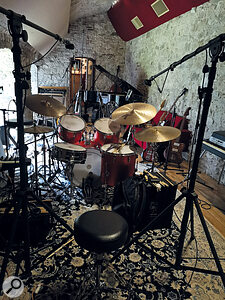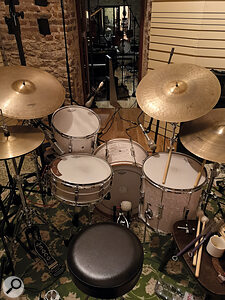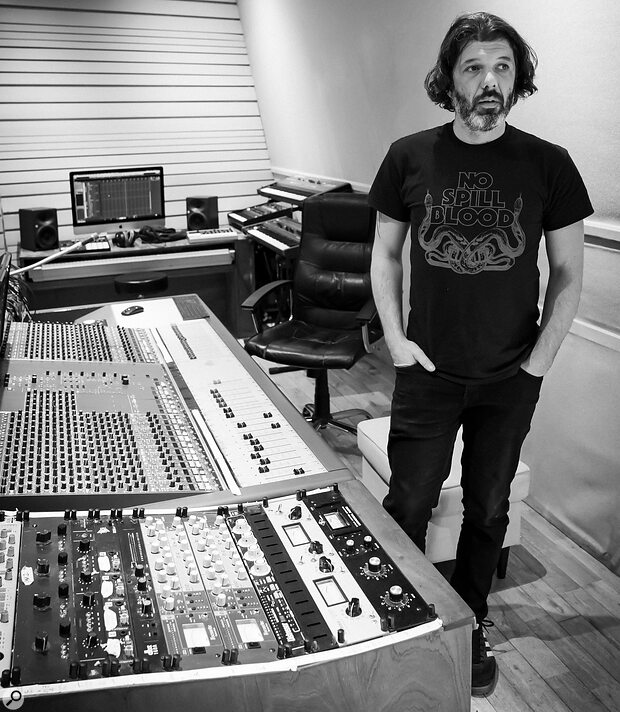One of Ireland’s busiest producers, John Murphy applies his love of studio experimentation to noise‑rock and traditional folk alike.
“A lot of bands have this mentality of ‘It needs to sound like it does when we play live!’” says John Murphy. “I think they’re two different things, and I like to try and expand on the sound when making an album. Use the tools to the best of your ability, and don’t be cheesy with them.”
This philosophy has made John one of the most sought‑after producers in Ireland. It also got him his big break, with a Dublin four‑piece who have put a rocket under the world of traditional folk music. “I was recording a lot of noise rock bands at the start. I was involved in the underground scene and then got offered gigs, like independent music TV shows. That was when I first met Lankum.”
Grow The Lows
Originally known as Lynched, the band were already frustrated at having to conform to the expectations of a conservative audience. Murphy inspired them to throw convention to the winds.
“When I met them, they were doing the UK folk circuit, and the demographic would have been quite old. So if Lankum were to play one of their own songs, they might get a negative reaction to it, whereas any of the stuff that was very standard folk, the old people were loving it. I think that was definitely playing on their minds a bit, whereas I was kind of the mentality of, ‘Well, fuck them.’ Music, for me, needs to keep expanding and growing. You need to try new things and not just be stuck in the same rut, or trying to copy or emulate or whatever.
“Prior to that, I’d started to do lots of manipulation to acoustic instruments. I had been experimenting with layering different instruments together and messing with octaves, and different things like that. The first time I recorded Lynched, the performance that they did was really special. That evening I went back to the studio and started to manipulate the low end on the recording. When they heard my mix I think they were initially a little bit shocked, but then they really enjoyed it. They realised that it sounded good and unique, and went with it. And then when we started to record albums together, the same thing started to happen.”
Dark Days
It’s an approach that is heard to good effect on the band’s recent album The Livelong Day. Although much of the material is traditional and the instrumentation acoustic, John Murphy’s contributions help to craft a claustrophobic, oppressive sound world that is a million miles from your typical Irish folk album.
“On The Livelong Day, we were in a studio for 13 days for the first session. The first couple of days was getting the room sounding good for the core takes, and then after that, I just started to add chains of different effects. Then, coming towards the end of the session, lots of it was being tracked live with the chain in place, with everything kind of sounding as it should be.
 It’s folk, Jim, but not as we know it: Lankum’s Ian Lynch with uillean pipes and pedalboard.“Generally with all the stuff that we record, there’s a core take, which is a vocal and a couple of instruments, to get the feel of the song correct. And then we start to layer instruments on top of that, or overdubs. Lots of them will be real; the acoustic guitar will sound like an acoustic guitar, the fiddle will sound like a fiddle. But because it’s folk music, there’s generally no bass. You know what I mean? There’s no drums or bass guitar, anything like that, so there’s a huge area to mess with and turn things up in!
It’s folk, Jim, but not as we know it: Lankum’s Ian Lynch with uillean pipes and pedalboard.“Generally with all the stuff that we record, there’s a core take, which is a vocal and a couple of instruments, to get the feel of the song correct. And then we start to layer instruments on top of that, or overdubs. Lots of them will be real; the acoustic guitar will sound like an acoustic guitar, the fiddle will sound like a fiddle. But because it’s folk music, there’s generally no bass. You know what I mean? There’s no drums or bass guitar, anything like that, so there’s a huge area to mess with and turn things up in!
“The manipulation is mainly with the bassier instruments, like the harmonium, the bayan, which is a Russian accordion that Radie plays, and the uilleann pipe drones from Ian. I add a lower octave to a few things, and then heavily compress it and put it into reverb and that kind of thing, just to add weight and bottom to it, but then it’s always in parallel. So you’re holding the acoustic tones up high and then just having something bubbling underneath. And then lots of ambient textual stuff is recorded. Again, all kept very subtle. It’s just like building a kind of a structure around that core take, whatever instruments were included.
“I’m kind of synthesizing the acoustic instruments. I’ll put maybe three mics on the instrument, one close getting the proper low end, maybe a contact mic, as well as having a condenser and a room mic on it. And then with that really close mic, I’ll send that through a pitch‑shifter and into a dirty compressor, and then EQ all of the frequencies that are jumping out. I mess around with sample rates quite a bit as well, doubling the sample rate and adding artifacts to it, and again, EQ’ing it and just leaving the frequencies that complement the original.”
In The Meadow
These techniques, explains John, work better when he can get reasonably clean signals from each instrument. This means there can be tension between the goals of minimising spill and getting a good core recording of the band playing together.
“I like to have as much separation as possible, because many instruments are quite different in volume, so there’ll be a lot of bleed. You’d have to use a huge amount of gain on certain things. So you get a lot of bleed from vocals coming in, et cetera. For the core take I would try to strip out as many instruments as possible and just have the driving instrument, or the rhythmic elements, I suppose, to keep the feel alive. And then, after the fact, overdub the rest of the instruments.
 This panoramic shot shows the live room at The Meadow as set up for basic tracking on Lankum’s The Livelong Day. The four band members (including Radie Peat, nearest to camera) were separated by a cross‑shaped arrangement of baffles, with mirrors at the centre of the cross enabling them to see one another.
This panoramic shot shows the live room at The Meadow as set up for basic tracking on Lankum’s The Livelong Day. The four band members (including Radie Peat, nearest to camera) were separated by a cross‑shaped arrangement of baffles, with mirrors at the centre of the cross enabling them to see one another.
“For The Livelong Day we recorded in The Meadow studio, which is in Wicklow in Ireland. It’s kind of set up to record string sections, so it has a massive live room with a good bit of reverb. The band were in a circle, in the same room, and I put baffles between them. So there was like an ‘X’ of baffles separating them if you know what I mean. Then, within the central part of that ‘X’, we had mirrors set up against the baffles, so that each player, through the mirror, could see the other players to their left and right, so that they were able to see each other’s fingers for timing, or faces for the nods and winks.”
Microphone choices were often dictated as much by the wish to minimise spill as by tonal preferences. “Because of the size of the room there was lots of bleed happening, so I was just trying to keep as much of that out of the vocal take as possible, but then lots of the vocals were overdubbed after the fact in Guerrilla [John’s own studio]. ‘Hunting The Wren’ would have been separately recorded. That’s a U47, if I remember correctly. ‘Katie Cruel’ was recorded live, but it was just Radie and her harmonium at the same time. We had a Coles on her voice and then, because she projects quite a lot in that track, there was a Beyer 201 and an M88, I think, on the harmonium, to try to keep her voice out of the harmonium mics. So it definitely changed for every song, to a certain extent, mainly trying to get the core take as clean as possible. An SM7 would have been used quite a bit as well on her, for all the extremely loud projection vocals, but the Coles generally works pretty good on her.”
 John Murphy behind the console at The Meadow with Lankum.
John Murphy behind the console at The Meadow with Lankum.
A Different Drummer
At the time of writing, production is nearing completion on a new Lankum record, again with Murphy at the controls, recorded this time at Hellfire Studios in the Dublin mountains. Meanwhile, the producer’s versatility is evident from another much‑hyped 2021 album, Black Midi’s Cavalcade. The follow‑up to the band’s Mercury Prize‑nominated debut Schlagenhelm, it’s a complete contrast to Lankum: a dizzying blend of prog, math‑rock, jazz and more, with astonishing musicianship on display throughout, especially from drummer Morgan Simpson.
“I had been a big fan of their music beforehand, so it was a little bit daunting going into the studio on the first day with them. I didn’t know how it was going to work, but we all got on really well, really quickly. They’re really lovely guys. Quite shy as well. We set up the drums and got the amps sounding good, and then we went for the first song. I think it was the second take of it and they were like, ‘Yeah, cool. That sounds good. Let’s move on.’ And then we did, I think, five tracks that day… We finished pretty early in the evening and then came back in the next day.
 Drummer Morgan Simpson used two kits during the tracking of Black Midi’s Cavalcade at Hellfire Studios. Unusual mic choices include the Electro‑Voice DS35 dynamic mic on snare (red kit) and rack tom (white kit).
Drummer Morgan Simpson used two kits during the tracking of Black Midi’s Cavalcade at Hellfire Studios. Unusual mic choices include the Electro‑Voice DS35 dynamic mic on snare (red kit) and rack tom (white kit). “We were doing the more jazzier‑sounding drums, like ‘Diamond Stuff’ and ‘Marlene Dietrich’ and ‘Ascending Fourths’. We set up Morgan’s jazz kit and put it into a different, smaller room, and again, just got it sounding good and started recording. Four hours later, we were done with all the drum takes. At the same time as this we recorded a guide guitar and a guide bass — or what I would’ve considered a guide guitar and a guide bass, but everything was so good that everything was kept!
“We were doing the more jazzier‑sounding drums, like ‘Diamond Stuff’ and ‘Marlene Dietrich’ and ‘Ascending Fourths’. We set up Morgan’s jazz kit and put it into a different, smaller room, and again, just got it sounding good and started recording. Four hours later, we were done with all the drum takes. At the same time as this we recorded a guide guitar and a guide bass — or what I would’ve considered a guide guitar and a guide bass, but everything was so good that everything was kept!
“Hellfire is an amazing space, it has numerous rooms that all sound unique — a big live room, a smaller tight room and a granite stone room — so you can either use these rooms to get separation on each instrument in a live take situation like this, or else use each room to capture a specific ambience or tone for overdubs. The main guitar and the main bass in all the songs are from the same take as the drums, with Geordie’s guitar amp set up in the granite room and Cameron’s bass amp set up in the small room. I think maybe we had to redo a chorus in one of the songs on the bass. They were really, really well‑rehearsed and really tight, and all the arrangements were really good. They’re so young as well. As soon as Morgan finished the first take, he started tuning the toms for the next song, and it was like, ‘Oh cool. We don’t have to explain this to the drummer.’
“It’s one of the first rock albums that I’ve done where I didn’t need to add in a sampled kick or a sampled snare. Everything came in perfect. Like I said, everyone was tuning after each song and getting ready for the next track. They’d done so much pre‑production before coming over, and he really knows his kits inside out. I had a faraway M‑S setup that caught a bit of the reverb in the room, then the main microphones were a set of Coles that were just set up left and right over the kit, and then I filled in around those with close mics on the kick and snare and toms.
“I remember seeing the waveforms as they were coming into Cubase and it looked compressed, his playing was so perfect. He was really listening to himself in the room and mixing the drums in his playing, so that the cymbals weren’t really splashy, the tone off the toms was really good, the kick and the snare were the correct level, the hats weren’t being hammered. It was the easiest drummer recording session I’ve ever had, I think! With some drummers you have to explain quite a bit — ‘Oh, the cymbals are really loud coming through all the mics’ — there was none of that. It just sounded really good.”

